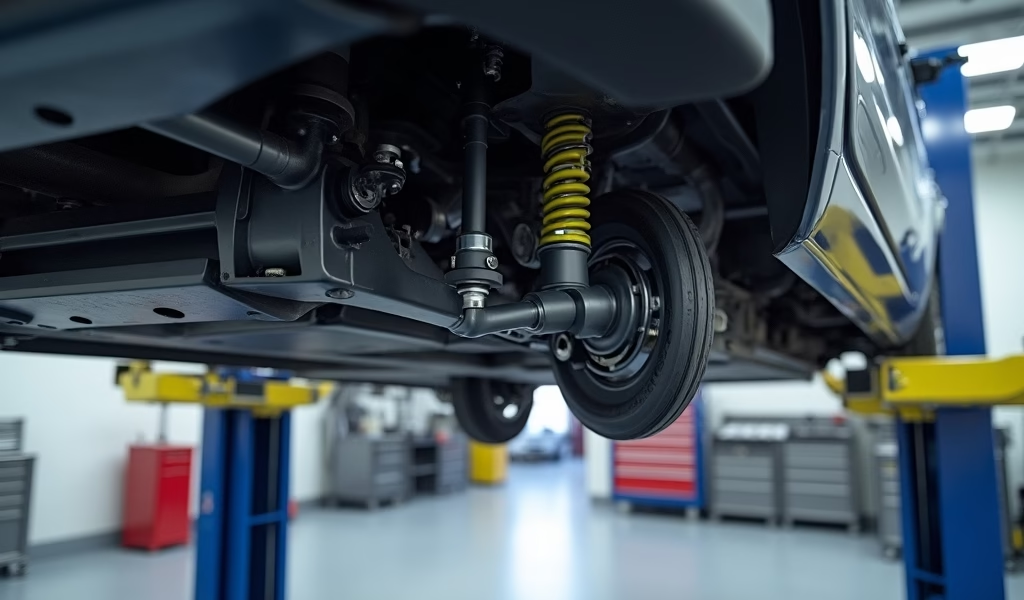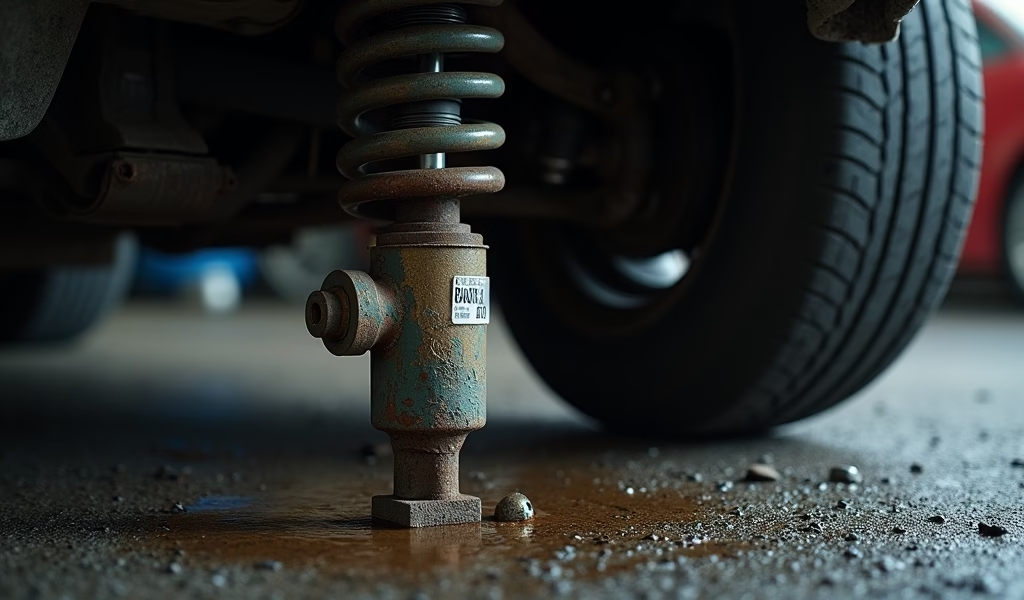Overview
This article provides five expert tips for selecting, installing, and maintaining shock absorber mounting hardware, emphasizing how these often-overlooked components significantly impact vehicle handling, safety, and comfort. The guide details the importance of choosing appropriate materials (rubber, polyurethane, or metal), performing regular inspections, following proper installation techniques, considering performance upgrades, and implementing preventive maintenance practices to maximize suspension system longevity.
Table of Contents
- Introduction
- Choose the Right Hardware Material
- Regular Inspection: Catching Problems Early
- Proper Installation Techniques
- Upgrade Options for Enhanced Performance
- Maintenance Best Practices
- Conclusion
- Frequently Asked Questions
Introduction
I’ve spent 20 years under hoods and chassis, and let me tell you—shock absorber mounting hardware deserves far more attention than it gets. These small components—the bushings, washers, sleeves, and bolts that connect your shocks to your vehicle’s frame—play a crucial role in your suspension system’s performance.
When mounting hardware fails, your entire driving experience suffers. That mysterious clunking noise over speed bumps? The increasingly unpredictable handling around corners? Both likely trace back to worn or failing mounting hardware. I’ve rescued countless vehicles from these symptoms by addressing what many overlook.
Your suspension literally hangs on these components. Let me walk you through five essential tips that will help you select, install, and maintain shock absorber mounting hardware for maximum performance and longevity. Your vehicle (and your passengers) will thank you.
Choose the Right Hardware Material
The material of your mounting hardware dramatically affects how your vehicle rides and handles. I’ve installed thousands of bushings, and the right choice always depends on how you use your vehicle.
Rubber bushings serve as the standard option in most factory vehicles. They excel at absorbing vibrations and delivering that smooth, quiet ride most drivers prefer. The downside? They deteriorate when exposed to heat, oils, and road chemicals. For daily drivers prioritizing comfort, rubber works perfectly fine if you’re prepared to replace them every 50,000-80,000 miles.
Polyurethane bushings offer the sweet spot between comfort and performance. I recommend these to most of my customers seeking an upgrade. They resist deterioration from elements that quickly destroy rubber and provide sharper handling response. You’ll notice a slightly firmer ride and occasionally more noise, but the trade-off brings exceptional durability and improved control.
Metal hardware, often featuring spherical bearings or “rod ends,” eliminates the flex inherent in rubber and polyurethane. I only recommend these for serious performance enthusiasts or track cars. While they provide unmatched precision, they transmit every bump and vibration directly into the cabin. Your spine will remind you of this choice on long drives.
Consider your driving style honestly before deciding. Weekend canyon carvers benefit from polyurethane’s responsiveness, while highway cruisers might prefer rubber’s compliance. Your climate matters too—extreme heat or cold accelerates rubber deterioration, making polyurethane a smarter long-term investment in challenging environments.

Regular Inspection: Catching Problems Early
In my shop, we preach preventive maintenance, and regular inspection of mounting hardware tops the list. I’ve saved customers thousands in repairs by catching minor issues before they became major headaches.
Watch for these telltale signs of mounting hardware deterioration:
- Visible cracking or splitting in rubber or polyurethane bushings
- Rust or corrosion on metal sleeves and washers
- “Squished” or deformed bushings that have lost their original shape
- Excessive movement or play at mounting points
- Oil saturation that causes rubber components to swell
I recommend inspecting your mounting hardware twice yearly, ideally during seasonal tire changes. However, if you hear unusual sounds—particularly clunking or knocking when crossing railroad tracks or speed bumps—perform an immediate inspection.
Worn mounting hardware doesn’t just affect comfort; it compromises safety. As bushings deteriorate, shock absorbers lose their ability to control rebound, reducing their effectiveness at managing wheel movement. This leads to increased stopping distances and unpredictable handling during emergency maneuvers.
According to AAA’s vehicle maintenance guidelines, suspension components should be inspected at least annually, with more frequent checks for vehicles regularly driven on rough roads. I’ve seen catastrophic failures that could have been prevented with a simple five-minute inspection.
Proper Installation Techniques
I’ve corrected countless improper installations over my career. Even premium mounting hardware performs poorly when installed incorrectly. Whether you’re a DIY enthusiast or working with a professional, understanding proper installation ensures quality results.
For successful installation, you’ll need:
- Socket set and wrenches
- Torque wrench (critical for proper bolt tightening)
- Bushing press or large C-clamps
- Penetrating oil for removing old hardware
- Anti-seize compound for new hardware
- Jack and jack stands for safe vehicle elevation
While specific procedures vary by vehicle, these universal principles apply:
Never reuse old mounting hardware. I know it’s tempting to save a few bucks, but internal fatigue remains invisible to the naked eye. New hardware costs far less than the consequences of failure.
Always torque to specifications. Under-tightening leads to movement and premature wear; over-tightening can crush bushings or strip threads. Consult your vehicle’s service manual or the hardware manufacturer for exact specifications.
Install bushings in a neutral position. The most common mistake I see involves tightening mounting bolts while the suspension hangs freely. This pre-loads stress into the bushings, dramatically shortening their lifespan. Always tighten mounting hardware with the suspension at normal ride height.
Use appropriate lubricants. Some polyurethane bushings require specific lubricants during installation to prevent squeaking. Follow manufacturer recommendations precisely—the wrong lubricant can actually accelerate deterioration.
Check alignment afterward. New mounting hardware affects wheel alignment, particularly if the old hardware was significantly worn. Professional alignment services ensure your new components deliver optimal handling and tire wear.
When replacing MacPherson strut bearings alongside your mounting hardware, pay special attention to the order of assembly. Incorrect sequencing creates binding that damages new components before they ever see real use.
Upgrade Options for Enhanced Performance
Factory mounting hardware represents a compromise between comfort, cost, and durability. I’ve helped hundreds of customers improve their vehicles’ handling through strategic mounting hardware upgrades.
Performance polyurethane kits from brands like Energy Suspension and Prothane offer complete bushing replacement packages that dramatically improve handling response. These kits typically cost between $100-250 depending on your vehicle and deliver noticeable improvements in steering precision and suspension control. The value proposition proves compelling: polyurethane typically lasts 2-3 times longer than rubber while enhancing performance.
For those seeking ultimate customization, adjustable mounting hardware allows fine-tuning of suspension geometry. These systems permit precise shock absorber angle adjustments to optimize handling characteristics. While overkill for most daily drivers, performance enthusiasts find these adjustments invaluable for dialing in exact handling preferences.
Vehicles regularly carrying heavy loads or operating in severe conditions benefit from specialized heavy-duty mounting hardware. Options reinforced with additional metal support prevent deformation under stress and maintain proper suspension geometry even when pushed to extremes.
When considering upgrades, balance your expectations honestly. A complete polyurethane bushing kit offers excellent returns for most enthusiasts, delivering tangible performance improvements without sacrificing daily drivability. However, full metal hardware makes little sense on a vehicle that never sees track use—the comfort penalty simply outweighs the marginal performance gain in normal driving.

Maintenance Best Practices
Once you’ve selected and properly installed quality mounting hardware, maintaining it properly maximizes its service life. I’ve seen well-maintained components last twice as long as neglected ones.
Regularly clean your suspension components, especially after winter driving. Road grime and salt accelerate deterioration. I recommend thorough cleaning with appropriate degreasers during seasonal changes to remove accumulated debris that traps moisture against mounting hardware.
Understand the lubrication requirements of your specific hardware. Unlike rubber bushings (which should never be lubricated after installation), polyurethane bushings sometimes benefit from periodic lubrication to prevent squeaking. Use only manufacturer-recommended products—typically specific polyurethane-safe lubricants—as petroleum-based products cause swelling and deterioration.
If you live in areas with harsh winters, apply protective treatments to metal components. I recommend specialized anti-corrosion sprays like Fluid Film that create a barrier against road salt and brine, preventing rust that eventually seizes bolts and complicates future maintenance.
Address issues immediately. That occasional squeak or knock may seem minor, but it signals movement where there should be none. Addressing these symptoms immediately prevents cascading damage to more expensive components. Remember: mounting hardware costs a fraction of what shocks, struts, or control arms do.
I’ve found that vehicles with protected and maintained mounting hardware often have suspension systems that last 30-50% longer than neglected ones. This maintenance doesn’t require special skills—just attention and preventive care.
Conclusion
Quality shock absorber mounting hardware forms the critical connection between your suspension components and vehicle frame. By selecting appropriate materials, performing regular inspections, ensuring proper installation, considering strategic upgrades, and maintaining components diligently, you’ll maximize both performance and longevity.
These five tips represent the foundation of suspension health. While mounting hardware may seem insignificant compared to the shocks themselves, I’ve seen time and again how these small components determine how the entire system performs. Like the foundation of a house, mounting hardware provides the stable base upon which everything else depends.
Whether you’re maintaining a family sedan or building a performance vehicle, giving mounting hardware the attention it deserves pays dividends in reliability, handling, and ride quality. Your vehicle will respond with improved performance, and you’ll avoid the costly repairs that come with neglect.
The next time you’re looking to improve your vehicle’s ride quality or addressing suspension issues, start with the mounting hardware. These often-overlooked components might just be the key to unlocking your vehicle’s true potential.
Frequently Asked Questions
How often should shock absorber mounting hardware be replaced?
Typically every 50,000-80,000 miles for rubber components, or when signs of wear appear. Polyurethane hardware can last significantly longer, often 100,000+ miles under normal conditions.
What are the symptoms of failing shock absorber mounting hardware?
Listen for clunking or knocking noises when driving over bumps and watch for excessive bounce after hitting dips. You may also notice uneven tire wear and a general deterioration in handling precision.
Can I mix different types of bushing materials in my suspension?
While technically possible, I don’t recommend mixing materials as it creates inconsistent handling characteristics. Keep all mounting points consistent with either all rubber or all polyurethane for predictable performance.
Is polyurethane mounting hardware worth the extra cost?
For most drivers who keep their vehicles more than a few years, absolutely yes. The improved durability and performance outweigh the modest price premium over standard rubber components.
Do I need an alignment after replacing shock absorber mounting hardware?
Yes, in most cases an alignment is necessary after replacing mounting hardware. New components alter suspension geometry enough to affect handling and tire wear.

